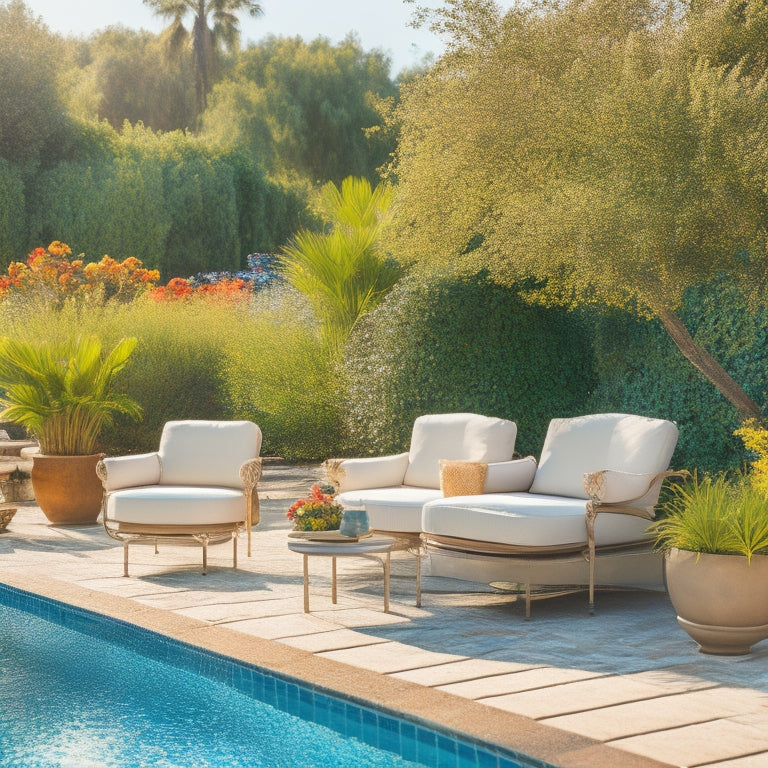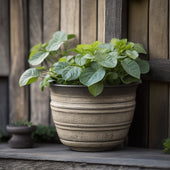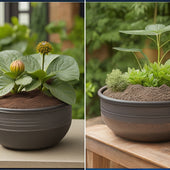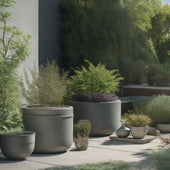
5 Best Poolside Planter Sizes for a Stunning Garden
Share
When selecting the ideal poolside planter size, you'll need to balance aesthetics with functionality, considering factors like cinder block dimensions, space constraints, planter depth, and material selection. Measure your pool area, ensuring at least 3-4 feet of clearance around the pool, and consider planter placement against walls or in corners. Choose from top planter size options like 18-20 inches for showcasing succulents, 24-28 inches for larger plants, or 32-36 inches for dramatic focal points. By weighing these factors, you'll create a stunning garden that complements your outdoor oasis, and discovering the perfect harmony of style and functionality awaits.
Key Takeaways
• Measure pool area and consider space constraints to determine ideal planter size and placement for a visually appealing layout.
• Select planter depth based on plant root system requirements, with shallow planters for herbs and deeper ones for larger plants or trees.
• Balance aesthetics with functionality by choosing planters that complement surroundings, withstand outdoor conditions, and adapt to seasonal changes.
• Consider larger planters (24-28 inches or more) for creating natural screens or focal points, and compact ones (12 inches) for accents or small spaces.
• Ensure planter size scales with furniture and architecture for a cohesive look, and prioritize harmony between aesthetics and functionality.
Cinder Block Planter Size Considerations
When designing a cinder block planter for your poolside oasis, consider the size of the blocks themselves, as they typically measure 8 inches high, 8 inches wide, and 16 inches long. This measurement will impact the overall dimensions of your planter.
You'll want to calculate the total number of blocks needed to achieve your desired planter size, taking into account the spacing between blocks and any additional features like caps or columns.
Keep in mind that cinder block dimensions will also influence planter weight considerations. A larger planter will require more blocks, increasing its overall weight and potentially affecting its stability.
You'll need to verify your planter's base is sturdy enough to support the weight of the blocks, soil, and plants. Visualize the finished product and consider the weight distribution to prevent any structural issues.
Measuring for Poolside Space Constraints
Before building your poolside planter, measure the space constraints around your pool to determine the maximum planter size that will fit comfortably, guaranteeing a safe and accessible walking path.
Take note of your pool's dimensions, including its length, width, and any obstructions like ladders or handrails. Consider the planter placement, too - will it be against a wall, in a corner, or freestanding?
Measure the clearance around the pool, paying attention to any areas where people will need to walk or pass through. You'll want to leave enough space for comfortable passage without feeling cramped or obstructed. A general rule of thumb is to leave at least 3-4 feet of clearance around the pool.
Use a tape measure or ruler to record the dimensions of the space where the planter will sit. Take photos or sketch out a rough diagram to help you visualize the layout.
With these measurements, you'll be able to determine the ideal planter size and shape to fit your poolside space. By taking the time to measure carefully, you'll guarantee a beautiful and functional planter that complements your pool area.
Choosing the Right Planter Depth
With your poolside space constraints mapped out, now focus on selecting a planter depth that harmonizes with your pool's aesthetic while accommodating the root systems of your chosen plants.
When it comes to planter depth, you'll want to take into account the mature size of your plants' root systems. For example, if you're opting for smaller herbs or succulents, a shallower planter depth of 6-8 inches will suffice. However, if you're planning to feature larger plants or trees, you'll need a deeper planter to provide adequate room for root growth – typically 12-18 inches or more.
During plant selection, research the specific root depth requirements for each species to guarantee you're providing the necessary space. A general rule of thumb is to choose a planter depth that's at least 1-2 inches deeper than the plant's root ball.
This allows for healthy root growth and prevents the soil from becoming waterlogged. By selecting the right planter depth, you'll be able to create a stunning poolside garden that not only looks beautiful but also thrives.
Balancing Aesthetics With Functionality
As you visualize your poolside oasis, harmony between aesthetics and functionality becomes essential, ensuring that your planters not only complement the surrounding landscape but also serve as a demonstration of your meticulous planning. You want your planters to be visually appealing, but also functional and adaptable to the changing seasons.
| Planter Feature | Aesthetic Consideration | Functional Benefit |
|---|---|---|
| Color | Coordinates with pool deck and surrounding decor | Enhances overall visual appeal |
| Size | Scales with surrounding furniture and architecture | Accommodates varying plant sizes and arrangements |
| Material | Blends with poolside materials (e.g., wood, metal, stone) | Withstands outdoor weather conditions |
When selecting planters, consider how they'll work together to create a cohesive look. Think about color coordination, ensuring your planters complement the pool deck, surrounding decor, and even the pool water itself. Additionally, choose planters that can adapt to seasonal changes, such as switching out plants or adding decorative elements to reflect the current season. By balancing aesthetics and functionality, you'll create a stunning poolside garden that's both beautiful and functional.
Top Poolside Planter Size Options
You'll need to choose from a range of planter sizes to find the perfect fit for your poolside oasis, from compact 12-inch containers to spacious 36-inch vessels that make a statement. The right planter size will depend on the scale of your pool area, the type of plants you want to feature, and the overall aesthetic you're aiming for.
For a cohesive look, consider the following popular planter size options:
-
18-20 inch planters: Ideal for showcasing colorful plant selections, such as succulents or blooming flowers, and adding a pop of color to your poolside decor.
-
24-28 inch planters: Perfect for creating a lush, verdant atmosphere with larger plants or small trees, and can be used to create a natural screen or divider.
-
32-36 inch planters: Make a statement with large, dramatic planters that can hold multiple plants or a small tree, and are ideal for creating a focal point in your pool area.
Frequently Asked Questions
How Often Should I Water Plants in Poolside Planters?
When it comes to watering plants in poolside planters, you'll want to strike the right balance.
Check the soil moisture daily, and water when the top inch feels dry.
You'll likely need to water every 2-3 days in the summer, but reduce the frequency to once a week in the spring and fall.
Make seasonal adjustments based on temperature and humidity.
For instance, you may need to water more frequently during heatwaves or less often during cooler, rainier periods.
Can I Use Self-Watering Planters by the Pool?
You're wondering if self-watering planters are a good fit by the pool.
Absolutely! They're a great choice, offering self-watering benefits that reduce planter maintenance.
These planters have a built-in water reservoir, which allows plants to draw water as needed. This means you'll spend less time watering and more time enjoying your poolside oasis.
With self-watering planters, you'll have better control over soil moisture, reducing the risk of overwatering and underwatering.
It's a win-win for you and your plants!
Are There Planters Specifically Designed for Saltwater Pools?
Imagine your poolside oasis, where lush greenery thrives amidst the salty mist.
You're wise to wonder: are there planters specifically designed for saltwater pools?
Yes, you'll find planters crafted from salt-resistant materials like fiberglass, resin, or ceramic, which can withstand the corrosive effects of saltwater.
These planters are engineered to maintain poolside aesthetics while protecting your plants from the harsh salt environment, giving you precise control over your pool's ambiance.
Do Poolside Planters Need Special Winter Storage?
When winter approaches, you'll want to guarantee your poolside planters are protected from harsh weather conditions.
You're smart to wonder if they need special winter storage. The answer lies in the planter materials.
If you've chosen planters made from fragile materials like ceramic or terra cotta, you'll need to provide winter protection to prevent cracking.
Move them to a sheltered area or cover them with a breathable cloth to safeguard your investment.
Can I Hang Planters From the Pool Fence or Surrounding Structures?
Imagine 75% of pool owners overlooking an essential detail: securing their planters.
When it comes to hanging planters from the pool fence or surrounding structures, you'll want to prioritize stability.
Ascertain your fence can withstand the weight of the planter, soil, and water by using sturdy hanging systems.
Avoid compromising fence stability, and instead, opt for reinforced brackets or consult with a structural expert to assure a secure and stunning display.
Conclusion
You've finally found the perfect planters to elevate your poolside oasis!
With these top picks, you'll be swimming in style in no time.
Remember, the right planter size is essential - it's the difference between a mediocre mess and a breathtaking backyard paradise that'll make your neighbors green with envy.
Choose wisely, and get ready to make a splash with your stunning garden!
Related Posts
-

What Makes a Beautiful Border Planter Design
When crafting a beautiful border planter design, you balance fundamental elements like durable cinder block structure...
-

What Makes a Beautiful Border Planter Design
When crafting a beautiful border planter design, you balance fundamental elements like durable cinder block structure...
-

What Makes a Beautiful Border Planter Design
When crafting a beautiful border planter design, you balance fundamental elements like durable cinder block structure...
-

What Makes a Beautiful Border Planter Design
When crafting a beautiful border planter design, you balance fundamental elements like durable cinder block structure...
-

What Makes a Beautiful Border Planter Design
When crafting a beautiful border planter design, you balance fundamental elements like durable cinder block structure...
-

What Makes a Beautiful Border Planter Design
When crafting a beautiful border planter design, you balance fundamental elements like durable cinder block structure...
-

What Makes a Beautiful Border Planter Design
When crafting a beautiful border planter design, you balance fundamental elements like durable cinder block structure...
-

What Makes a Beautiful Border Planter Design
When crafting a beautiful border planter design, you balance fundamental elements like durable cinder block structure...
-

What Makes a Beautiful Border Planter Design
When crafting a beautiful border planter design, you balance fundamental elements like durable cinder block structure...
-

What Makes a Beautiful Border Planter Design
When crafting a beautiful border planter design, you balance fundamental elements like durable cinder block structure...
-

What Makes a Beautiful Border Planter Design
When crafting a beautiful border planter design, you balance fundamental elements like durable cinder block structure...
-

What Makes a Beautiful Border Planter Design
When crafting a beautiful border planter design, you balance fundamental elements like durable cinder block structure...
-

What Makes a Beautiful Border Planter Design
When crafting a beautiful border planter design, you balance fundamental elements like durable cinder block structure...
-

What Makes a Beautiful Border Planter Design
When crafting a beautiful border planter design, you balance fundamental elements like durable cinder block structure...
-

What Makes a Beautiful Border Planter Design
When crafting a beautiful border planter design, you balance fundamental elements like durable cinder block structure...
-

What Makes a Beautiful Border Planter Design
When crafting a beautiful border planter design, you balance fundamental elements like durable cinder block structure...
-

What Makes a Beautiful Border Planter Design
When crafting a beautiful border planter design, you balance fundamental elements like durable cinder block structure...
-

What Makes a Beautiful Border Planter Design
When crafting a beautiful border planter design, you balance fundamental elements like durable cinder block structure...
-

What Makes a Beautiful Border Planter Design
When crafting a beautiful border planter design, you balance fundamental elements like durable cinder block structure...
-

What Makes a Beautiful Border Planter Design
When crafting a beautiful border planter design, you balance fundamental elements like durable cinder block structure...
-

What Makes a Beautiful Border Planter Design
When crafting a beautiful border planter design, you balance fundamental elements like durable cinder block structure...
-

What Makes a Beautiful Border Planter Design
When crafting a beautiful border planter design, you balance fundamental elements like durable cinder block structure...
-

What Makes a Beautiful Border Planter Design
When crafting a beautiful border planter design, you balance fundamental elements like durable cinder block structure...
-

What Makes a Beautiful Border Planter Design
When crafting a beautiful border planter design, you balance fundamental elements like durable cinder block structure...
-

What Makes a Beautiful Border Planter Design
When crafting a beautiful border planter design, you balance fundamental elements like durable cinder block structure...
-

What Makes a Beautiful Border Planter Design
When crafting a beautiful border planter design, you balance fundamental elements like durable cinder block structure...
-

What Makes a Beautiful Border Planter Design
When crafting a beautiful border planter design, you balance fundamental elements like durable cinder block structure...
-

What Makes a Beautiful Border Planter Design
When crafting a beautiful border planter design, you balance fundamental elements like durable cinder block structure...
-

What Makes a Beautiful Border Planter Design
When crafting a beautiful border planter design, you balance fundamental elements like durable cinder block structure...
-

What Makes a Beautiful Border Planter Design
When crafting a beautiful border planter design, you balance fundamental elements like durable cinder block structure...
-

What Makes a Beautiful Border Planter Design
When crafting a beautiful border planter design, you balance fundamental elements like durable cinder block structure...
-

What Depth Is Best for My Planter
When selecting a planter, consider the root depth requirements of your chosen plant species, as this dictates the min...
-

What Depth Is Best for My Planter
When selecting a planter, consider the root depth requirements of your chosen plant species, as this dictates the min...
-

What Depth Is Best for My Planter
When selecting a planter, consider the root depth requirements of your chosen plant species, as this dictates the min...
-

What Depth Is Best for My Planter
When selecting a planter, consider the root depth requirements of your chosen plant species, as this dictates the min...
-

What Depth Is Best for My Planter
When selecting a planter, consider the root depth requirements of your chosen plant species, as this dictates the min...
-

What Depth Is Best for My Planter
When selecting a planter, consider the root depth requirements of your chosen plant species, as this dictates the min...
-

What Depth Is Best for My Planter
When selecting a planter, consider the root depth requirements of your chosen plant species, as this dictates the min...
-

What Depth Is Best for My Planter
When selecting a planter, consider the root depth requirements of your chosen plant species, as this dictates the min...
-

What Depth Is Best for My Planter
When selecting a planter, consider the root depth requirements of your chosen plant species, as this dictates the min...
-

What Depth Is Best for My Planter
When selecting a planter, consider the root depth requirements of your chosen plant species, as this dictates the min...
-

What Depth Is Best for My Planter
When selecting a planter, consider the root depth requirements of your chosen plant species, as this dictates the min...
-

What Depth Is Best for My Planter
When selecting a planter, consider the root depth requirements of your chosen plant species, as this dictates the min...
-

What Depth Is Best for My Planter
When selecting a planter, consider the root depth requirements of your chosen plant species, as this dictates the min...
-

What Depth Is Best for My Planter
When selecting a planter, consider the root depth requirements of your chosen plant species, as this dictates the min...
-

What Depth Is Best for My Planter
When selecting a planter, consider the root depth requirements of your chosen plant species, as this dictates the min...
-

What Depth Is Best for My Planter
When selecting a planter, consider the root depth requirements of your chosen plant species, as this dictates the min...
-

What Depth Is Best for My Planter
When selecting a planter, consider the root depth requirements of your chosen plant species, as this dictates the min...
-

What Depth Is Best for My Planter
When selecting a planter, consider the root depth requirements of your chosen plant species, as this dictates the min...
-

What Depth Is Best for My Planter
When selecting a planter, consider the root depth requirements of your chosen plant species, as this dictates the min...
-

What Depth Is Best for My Planter
When selecting a planter, consider the root depth requirements of your chosen plant species, as this dictates the min...
-

What Depth Is Best for My Planter
When selecting a planter, consider the root depth requirements of your chosen plant species, as this dictates the min...
-

Summer Care Tips for Concrete Planters
As you step into the warmest season of the year, your concrete planters require deliberate care to thrive. Clean your...
-

Summer Care Tips for Concrete Planters
As you step into the warmest season of the year, your concrete planters require deliberate care to thrive. Clean your...
-

Summer Care Tips for Concrete Planters
As you step into the warmest season of the year, your concrete planters require deliberate care to thrive. Clean your...
-

Summer Care Tips for Concrete Planters
As you step into the warmest season of the year, your concrete planters require deliberate care to thrive. Clean your...
-

Summer Care Tips for Concrete Planters
As you step into the warmest season of the year, your concrete planters require deliberate care to thrive. Clean your...
-

Summer Care Tips for Concrete Planters
As you step into the warmest season of the year, your concrete planters require deliberate care to thrive. Clean your...
-

Summer Care Tips for Concrete Planters
As you step into the warmest season of the year, your concrete planters require deliberate care to thrive. Clean your...
-

Summer Care Tips for Concrete Planters
As you step into the warmest season of the year, your concrete planters require deliberate care to thrive. Clean your...
-

Summer Care Tips for Concrete Planters
As you step into the warmest season of the year, your concrete planters require deliberate care to thrive. Clean your...
-

Summer Care Tips for Concrete Planters
As you step into the warmest season of the year, your concrete planters require deliberate care to thrive. Clean your...
-

Summer Care Tips for Concrete Planters
As you step into the warmest season of the year, your concrete planters require deliberate care to thrive. Clean your...
-

Summer Care Tips for Concrete Planters
As you step into the warmest season of the year, your concrete planters require deliberate care to thrive. Clean your...
-

Summer Care Tips for Concrete Planters
As you step into the warmest season of the year, your concrete planters require deliberate care to thrive. Clean your...
-

Summer Care Tips for Concrete Planters
As you step into the warmest season of the year, your concrete planters require deliberate care to thrive. Clean your...
-

Summer Care Tips for Concrete Planters
As you step into the warmest season of the year, your concrete planters require deliberate care to thrive. Clean your...
-

Summer Care Tips for Concrete Planters
As you step into the warmest season of the year, your concrete planters require deliberate care to thrive. Clean your...
-

Summer Care Tips for Concrete Planters
As you step into the warmest season of the year, your concrete planters require deliberate care to thrive. Clean your...
-

Summer Care Tips for Concrete Planters
As you step into the warmest season of the year, your concrete planters require deliberate care to thrive. Clean your...
-

Summer Care Tips for Concrete Planters
As you step into the warmest season of the year, your concrete planters require deliberate care to thrive. Clean your...
-

Summer Care Tips for Concrete Planters
As you step into the warmest season of the year, your concrete planters require deliberate care to thrive. Clean your...
-

Summer Care Tips for Concrete Planters
As you step into the warmest season of the year, your concrete planters require deliberate care to thrive. Clean your...
-

Summer Care Tips for Concrete Planters
As you step into the warmest season of the year, your concrete planters require deliberate care to thrive. Clean your...
-

Summer Care Tips for Concrete Planters
As you step into the warmest season of the year, your concrete planters require deliberate care to thrive. Clean your...
-

Summer Care Tips for Concrete Planters
As you step into the warmest season of the year, your concrete planters require deliberate care to thrive. Clean your...
-

Summer Care Tips for Concrete Planters
As you step into the warmest season of the year, your concrete planters require deliberate care to thrive. Clean your...
-

Summer Care Tips for Concrete Planters
As you step into the warmest season of the year, your concrete planters require deliberate care to thrive. Clean your...
-

Summer Care Tips for Concrete Planters
As you step into the warmest season of the year, your concrete planters require deliberate care to thrive. Clean your...
-

Summer Care Tips for Concrete Planters
As you step into the warmest season of the year, your concrete planters require deliberate care to thrive. Clean your...
-

Summer Care Tips for Concrete Planters
As you step into the warmest season of the year, your concrete planters require deliberate care to thrive. Clean your...


